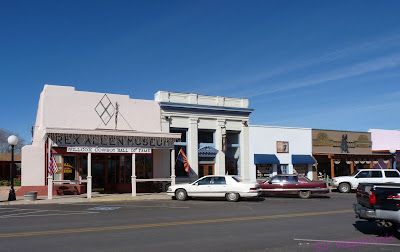This year I decided to arrange a stay of a week's time so we could play golf in Sunsites and check out the Rex Allen Museum and get some cider. Well, two out of three is not bad.
It seems the town of Willcox has been hard hit by the recession and a lot of the local restaurants and motels have closed down. The Cider Mill was victim to the economy also, shutting down after selling locally grown apples and apple products for twenty-plus years. When you ask folks where to eat they recommend the Big Tex BBQ place or "The Plaza" which is a little restaurant at the truck stop along the interstate. Driving through downtown there are almost as many empty storefronts as there are those still in business and there's not much traffic on the roadways. It only takes a few minutes to navigate most of the town, so after driving around a bit one day we stopped at the Rex Allen Museum.
Growing up in the 50s and 60s my heroes were cowboys: Roy Rogers, the Lone Ranger, Gene Autry, the Rifleman, Sugarfoot, Sky King and more. Rex Allen wasn't a name I was familiar with but I figured he was a contemporary of Roy Rogers and that was good enough for me.
Located on N. Railroad Avenue near the middle of town, when you pull up to park across the street you discover a statue of Rex Allen himself as well as a separate memorial to his horse, Koko. Once Denny and I went inside the museum, we were immediately informed by one of the staff there that Rex had been cremated upon his death and part of his ashes were scattered by Koko's memorial at his request while the other half were scattered at Rex's parents' gravesites.
It will cost a couple all of $3 to tour the museum; $2 if you are a single. On the day Denny and I visited we were met at the door by two employees who had obviously worked together a long time; like an old married couple they finished each others statements and bantered back and forth like an amateur comedy team. It turns out that one of the men was from Ohio originally while the other was a native of Willcox. Denny and I chatted with them almost as long as we spent wandering the small museum.
Real cowboys wear spangles. Most of Rex's outfits were created by Nudie, while his boots were by Tony Lama. In addition to being in movies, Rex Allen had a long recording career and worked in radio, making many public appearances, usually with his beloved horse Koko (nicknamed the Miracle Horse of the Movies.)
The minimum requirements to be a cowboy, as posted in the museum.
It's not going to take you a long time to cover the entire museum, but it was an interesting way to spend the morning and bring back memories of sitting in front of the TV on a Saturday morning enthralled by the cowboys racing across the small screen. And that was certainly worth the $3.





























